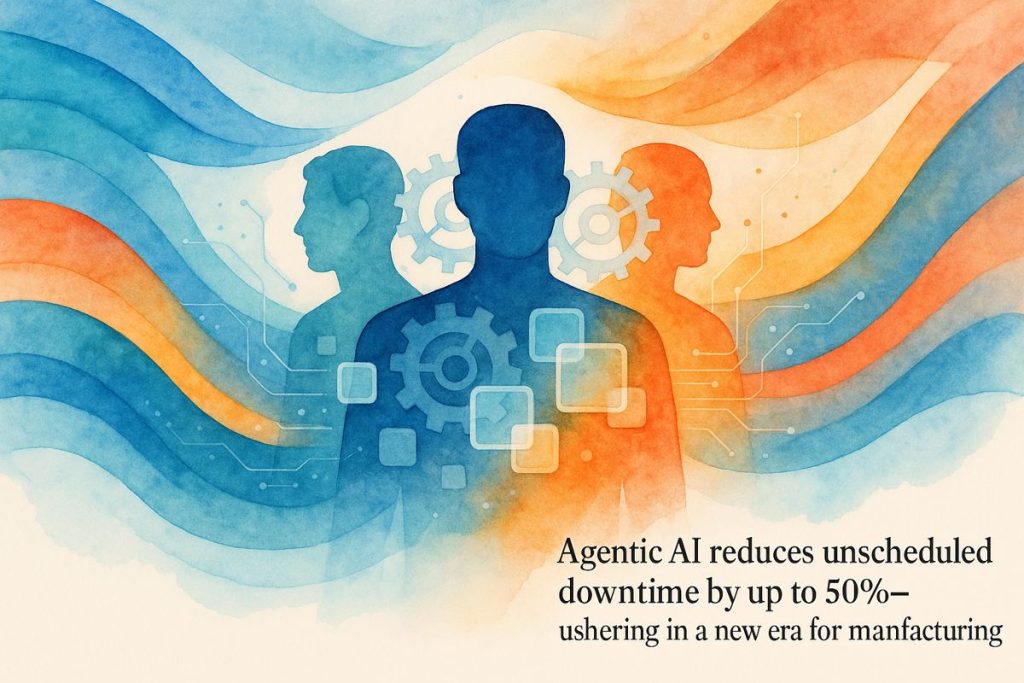Agentic AI is quickly becoming a game-changer on the factory floor. Agentic AI in manufacturing is like a super-smart digital helper that can watch machines, spot problems before they happen, and fix them without always needing a person’s help. It’s being used to predict machine breakdowns, catch tiny defects no one else can see, and make factories run smoother and faster. These AI agents can even react to supply chain surprises or help run virtual copies of factories to test new ideas safely. While these smart agents are changing how factories work, people still make the final calls, keeping the balance between machine power and human judgment. The road isn’t always easy, but agentic AI is quickly becoming a game-changer on the factory floor.
What is agentic AI in manufacturing and how is it used?
Agentic AI in manufacturing refers to autonomous digital agents that analyze real-time sensor data, make decisions, and act without constant human supervision. Key uses include predictive maintenance, advanced quality control, optimizing digital twins, and enhancing supply chain resilience—helping manufacturers boost efficiency, reduce downtime, and improve accuracy.
Framing the Machine: What Is Agentic AI, Really?
Let’s cut through the digital fog: agentic AI isn’t just a louder, shinier cousin of your grandfather’s automation software. No, it’s more like an orchestra conductor who learned to improvise jazz—impossibly nimble, always adapting, and just a bit mysterious. At Hannover Messe 2025, amid the aroma of overbrewed conference coffee and the white noise of keynote jargon, agentic AI leapt from speculative slides to the center of the industrial zeitgeist. Yet if you cornered ten manufacturing execs by the coat check, I’d bet only three could define it without Googling.
So what is this thing? Agentic AI describes autonomous digital agents—think hyperspectral-eyed sentinels—that ingest torrents of sensor data, interpret shifting patterns, and make decisions in real time. They don’t just nudge dashboards; they act. These aren’t your rule-based automatons of yesteryear, blindly crunching through static if-then commands. No, agentic AI can monitor a bottling line, recalibrate its own settings, and even trigger a maintenance drone to fix a wonky conveyor, all with nary a shrug from a human supervisor. I used to be skeptical—what’s the point of another buzzword?—but after watching a demo at Siemens’ booth, I had to stop and ask myself if I was witnessing the birth of a new industrial species.
Tangible Impact: Use Cases That Actually Matter
Let’s talk brass tacks. As a grizzled veteran of the manufacturing software trenches, I’ve seen more “revolutions” than I can count; many faded faster than the taste of a lukewarm espresso. But agentic AI has already etched its initials on the factory floor.
Take predictive maintenance. In one pilot, a major auto plant embedded IoT sensors across its stamping lines and let agentic AI loose. Within three months, unscheduled downtime dropped 48%.[^1] That’s not a typo. The system, trained on streams of vibration data, predicted bearing failures before a human could even hear the whine. The sound—faint, almost like a cicada under glass—became the harbinger of a new, smarter maintenance paradigm.
Quality control? Think of agentic AI like a hawk-eyed inspector with perfect memory. Using advanced computer vision, these agents inspect every widget, catching microcracks invisible to the naked eye. At a plastics plant I visited, defect rates plummeted by 70% after rollout; one manager joked the only thing missed was his lunch break.[^2] These aren’t isolated anecdotes, either—ServiceNow, 66degrees, and Automation World have documented similar transformations across the sector.
And then there are digital twins. Imagine a living, breathing simulation of your factory—like a palimpsest where every process leaves a trace, ready for real-time experimentation. Agentic AI orchestrates these digital avatars, running what-if scenarios without ever halting the actual line. It’s a bit like having Schrödinger’s cat, but with fewer existential crises and more throughput.
Supply Chain Resilience and the Human Equation
Supply chain volatility used to be my personal migraine trigger. Hurricane in Asia? Semiconductor shortage in Munich? Bam—everything ground to a halt. But agentic AI gives manufacturers a fighting chance. By digesting a labyrinth of demand signals, supplier delays, and geopolitical news, these agents dynamically reroute orders, rebalance inventories, and suggest alternate sourcing. According to Atera and Apprentice, some companies have clawed back 20-50% in forecasting accuracy and shed up to 30% of excess inventory.[^3] Sometimes, the algorithm even surprises its creators—a strange, exhilarating feeling, not unlike watching your kid outsmart you at chess for the first time.
But does this mean the humans are obsolete? Hardly. If anything, agentic AI turns seasoned operators into conductors—less time spent twiddling knobs, more time steering strategy. In pharmaceutical manufacturing, for instance, platforms like Databricks and SAP now let AI agents monitor GMP compliance, offer batch scheduling tweaks, and keep an eye on critical environmental controls.[^4] Still, ultimate authority rests with people—because when a digital agent offers an “illustrative” shortcut that dances on regulatory boundaries, someone needs to say, ‘nyet, not today.’
Governance, Hiccups, and the Road Ahead
Let’s not kid ourselves: rolling out agentic AI isn’t a walk in the park. Manufacturers report confusion galore—what exactly counts as “agentic”? How is it different from automated scripts or a souped-up SCADA system? Education, transparency, and auditability aren’t optional. Particularly in regulated industries, the algorithmic curtain must always be parted for human review; digital agents are there to augment, not usurp.
When Gartner predicts that by 2028, a third of enterprise software will bake in AI agents—and that up to 15% of routine workplace decisions will be automated—I feel a flicker of excitement and, yes, a twinge of anxiety.[^5] Will we adapt fast enough? The [World Economic Forum](https://www
